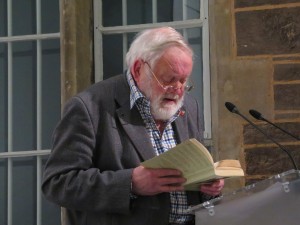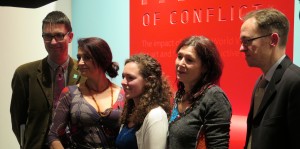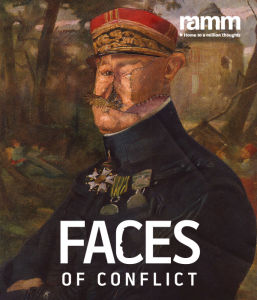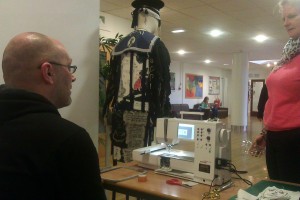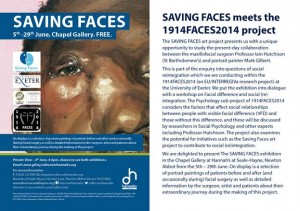Patria Obscura is a documentary film made by Stéphane Ragot under the auspices of 1914FACES2014. In Patria Obscura, the military past is addressed through the lens of family history and remembrance, including Ragot’s own memories of his grandfathers. The film engages with the history of the gueules cassées, and will be screened at the University of Exeter on 26th May 2015. The screening will take place from 19:00-21:30 in Queen’s Building LT6.1. All welcome.
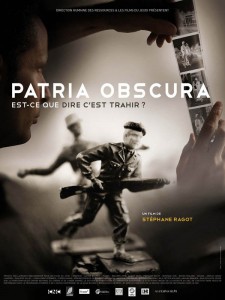
Author Archives: David Houston Jones
Faces of Conflict exhibition opening: Royal Albert Memorial Museum & Art Gallery, with Michael Longley
Faces of Conflict, the major UK exhibition arising from 1914FACES2014, opened at the RAMM on 17th January 2015. The private view was accompanied by a uniquely moving and powerful reading by Michael Longley, CBE. Michael read from his recent collection The Stairwell (2014) and spoke about the key role played by the First World War in his poetic creation.
Michael’s father served as the teenage commander of ‘Longley’s Babies’, one of the London-Scottish regiment’s infantry companies. Michael’s father’s experience marks Michael’s own reflections on a variety of conflicts from different historical periods, and The Stairwell sees remarkable juxtapositions of scenes from the Trojan wars and the First World War. In particular, Michael’s poem ‘The Tin Noses Shop’ offers a glimpse of the gueules cassées and of Anna Coleman Ladd’s work to create portrait masks in the war years. We were honoured to be able to include this work and Michael’s equally striking work ‘Face’ in the exhibition.
Faces of Conflict explores the long-lasting influence upon artists and surgeons of the facial injuries suffered during the First World War, and includes contemporary work by Paddy Hartley, Eleanor Crook, Rene Apallec in dialogue with a range of historical artefacts.
The exhibition is at the RAMM until 5th April 2015.
Disfigurement & its legacies conference programme
Please register at the following link:
Les Gueules cassées: disfigurement and its legacies
University of Exeter, 12th-14th March 2015
FACES legacies full programme jan 2015 – public
Programme
Thursday 12th March 2015
12.00 onward Registration
12.30-1.30pm Buffet Lunch
12.30-1.30 Artist’s demonstration: Paddy Hartley
1.30 -3.00pm Welcome; Panel sessions
1. Revisiting the Stories of WWI Disfigured men
i) Anna Branach-Kallas: ‘Abjection, Masks, and Cultural Trauma: Les Gueules Cassées in Recent Great War Fiction in English and French’
ii) Marzena Sokołowska-Paryż: ‘The Ideological ‘Faces’ of the Great War: the ‘Culture of Aversion’ versus the Post-Memory Culture of Empathy
iii) Suzanne Steele: ”The Tin Nose Shop’: les gueules cassées and Michael Longley’s Great War poetry’
2. Visual Representations of Disfigurement
i) Emmanuelle Raingeval : ‘L’atelier des masques : quand la sculpture se fait soin’
ii) Rossella Bondi: ‘Giorgio de Chirico and Alberto Savinio: the Aesthetic of the Faceless Man during World War I
iii) Nicola Baird: ‘Let the atrocious images haunt us’: Artistic Representations of and Responses to the Disfigured Faces of the Great War
3.00-3.30pm Tea & Postgraduate Poster Session, Innovation Centre: Art, Medicine and the Face
3.30-5.00pm PANEL SESSIONS
3. Responses to Disfigurement in the Visual Arts
i) Monika Keska: ‘Deformity and Facial Disfigurement in Francis Bacon’s Portraiture’
ii) Paul Rousseau: ‘Francis Bacon and the Visages of War’
iii) Geneviève Guetemme : ‘Kader Attia ou la Grande guerre et ses masques’
4. Disfigurement before the First World War
i) Patricia Skinner: FACES9141014 [sic]- Taking the Long View on Disfigurement
ii) Michelle Webb: ‘I did perfectly make him whole’: Facial Damage, Surgery and Objectification in England, c.1500 – 1700.
iii) Céline Cherici: ‘Alexis Carrel et la grande guerre’
5.00-5.15pm Tea/Coffee
5.15-6.00 Artist’s demonstration: Eleanor Crook: tube pedicle
6.00-6.45pm Plenary Lecture, Alumni Auditorium, Forum
Prof Bernard Devauchelle, Institut Faire Faces
La Chirurgie nouvelle (or the birth of cosmetic surgery)
6.45pm Reception & refreshments
Visit, Saving Faces exhibition, Forum
Friday 13th March 2015
9.00-11.00am Surgery and the Face
i) Jean-Claude Dupont: ‘Les blessures de la tête et la Grande Guerre’
ii) Andrew Brown: ‘From Gillies to the Guinea Pigs’
iii) Julie Mazaleigue-Labaste: ‘Les cultures médicales face aux Gueules Cassées : place et fonction des croisements entre chirurgie et odontologie dans le soin des blessures de la face, à partir du cas d’Albéric Pont’
iv) Kanika Sharma: ‘Disfigurement and Reconstructive Surgery: the case of acid attack survivors in India’
Archives & Museum Studies
i) Ruth Neave: ‘“The Progress of Plastic Surgery” An Insight into the Archives of BAPRAS’
ii) David Houston Jones: ‘Facial repair: from the Medical Archive to contemporary artistic practice’
iii) Paddy Hartley, ‘Patchwork narratives and the archive: a visual interpretation of the life of Walter Yeo’
11.00-11.30am Tea/Coffee
11.30-12.45 Plenary Lecture
James Partridge (Founder and Chief Executive, Changing Faces), “Facial disfigurement and fairness: a journey… from Sidcup to today and tomorrow…”
Chair : Manuela Barreto
12.45-1.45pm Lunch, Innovation Centre
2.00-3.15pm Visit, Faces of Conflict exhibition, Royal Albert Museum and Art Gallery
3.15-3.45 Tea & coffee
3.45-5.15pm PANEL SESSIONS
7. Photography
i) Jason Bate: ‘At the cusp of medical research: surgical societies, facial injuries, and the role of photography in exchanging, debating, and disseminating methods and ideas during the First World War’
ii) Beatriz Pichel: ‘Portraying the Gueules Cassées: Photography and the Making of Disfigurement (1914-1932)’
iii) Ulrike Zitzlsperger: ‘Losing Faces – Gaining Perspectives in 1920s Germany’
8. Disfigurement and identity
i) Sophie Cremades: ‘La naissance d’un visage, une identité en marche’
ii) François Delaporte: ‘De la face au masque : les questions de l’identité au sortir de la Grande guerre’
iii) Anne-Marie Martindale: ‘When I look in the mirror, I see a mixture of the two [of us]”: Some thoughts on identity shift and facial transplantation’
5.15-5.45 Refreshments
5.45-6.45pm Plenary Lecture
Louisa Young, Innovation Centre
‘My Dear, I Wanted to Tell You that I have received a Slight/Serious Wound…. ‘: A novelist’s approach to the human, individual and family experience of maxillofacial reconstruction in WWI.
7.30pm Conference dinner, Rougemont Hotel
Saturday 14th March 2015
9.00-11.00am PANEL SESSIONS
9. Film studies
i) Joe Kember: ‘Face Value: Robert Florey and the Representation of the Gueules Cassées in Hollywood’
ii) Evelyne Jardonnet: ‘Défigurations dans le cinéma de la Grande Guerre : de l’infilmable à l’image-spectrale’
iii) Karine Chevalier: ‘The Disfigured Face or the Absent Signifier: Faces and Masks in French Cinema’
iv) Richard Woodall: ‘“Circus of Horrors”: Disfiguring the Feminine in 1960s Cinema’
10. Literary representations of disfigurement and identity
i) Martin Hurcombe: ‘The Return of the Brute’
ii) Kate Macdonald: ‘The facially impaired First World War soldier in British popular culture’
iii) Kamilla Pawlikowska: ‘Imagination, the Face and Surgical Intervention’
iv) Marjorie Gehrhardt: ‘La Greffe Générale‘
11.00-11.30am Tea and Coffee
11.30-12.45pm Plenary Lecture
Dr Suzannah Biernoff, Birkbeck, University of London
85 Portraits of War
Chair: David Houston Jones
12.45-13.45pm Lunch
13.45-15.45 Panel sessions
11. Artistic Practice
i) Mark Gilbert: ‘The Experience of Portraiture in a Clinical Setting’
ii) Luke Shepherd: ‘If a surgeon can’t draw, would you trust them to hold a scalpel?’
iii) Karen Shepherdson: ‘Picturing Aftermath – a visual response to the broken faces of the First World War’
iv) Eleanor Crook: tbc
12. Psyche and Society
i) Sophie Delaporte: ‘L’atteinte, XIXe-XXIe siècle’
ii) Marie Le Clainche-Piel: ‘Committing to Face Transplantation: From the Challenge of Singularity to the Return to the Community’
iii) Emmylou Rahtz: ‘The complex course of psychological distress following facial injury’
15.45-16:15 Tea & coffee
END OF CONFERENCE
Exhibitions
Faces of Conflict: the impact of the First World War on art and facial reconstructive surgery
Royal Albert Memorial Museum and Art Gallery, Exeter
17th January – 4th April 2015
This exhibition takes the experience of the facially injured soldiers of the First World War as the starting-point for an enquiry into disfigurement in the broadest sense. It creates a dialogue between work created during and immediately after the First World War and the work of contemporary artists including the work of Paddy Hartley, artist in residence, College of Humanities.
Saving Faces meets 1914FACES2014
Exhibition of portrait paintings by Mark Gilbert 24th February – 26th March, University of Exeter, Forum (main campus)
Our presentation of the Saving Faces exhibition is part of a research-led enquiry into questions of social reintegration. The Saving Faces art project presents us with a unique opportunity to study the present-day collaboration between the maxillofacial surgeon Professor Iain Hutchison (St Bartholomew’s) and the acclaimed Glaswegian portrait painter Mark Gilbert.
Exhibition opening, Faces of Conflict
Paddy Hartley in the College of Humanities
As part of Paddy’s work on 1914FACES2014 he has recently been in action in Queen’s (College of Humanities) making fabric-based pieces which will form part of the exhibition Faces of Conflict at the RAMM in 2015.
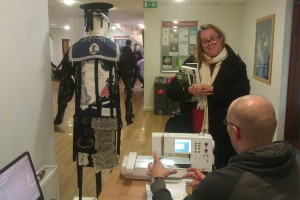
Paddy is seen here making digital embroidery work in which digitally-edited designs are sent to a networked sewing machine. Paddy’s workspace in Queen’s is next to his earlier uniform sculpture Walter Ernest O’Neil Yeo (Sailor Uniforms, digital embroidery, lazertran digital fabric print)
Les Gueules cassées: disfigurement and its legacies
Call for papers : Les Gueules cassées: disfigurement and its legacies
University of Exeter, 12th-14th March 2015
The experience of the gueules cassées has given rise to a unique cultural history, and one which is now being rewritten in the centenary years of the First World War. This conference, arising from the INTERREG IV-funded project 1914FACES2014, led by the Institut Faire Faces and the University of Exeter, assesses the legacy of the gueules cassées.
The First World War saw facial injury on an unprecedented scale: new types of weaponry meant that facial injury became more common and greater numbers of wounded survived. As a result, WWI and its immediate aftermath saw unprecedented innovations in the surgical field, with surgeons such as Hippolyte Morestin and Harold Gillies pioneering techniques which would transform facial reconstructive surgery. Just as artistic practice fed into surgical practice (in the work of sculptors as mask-makers or epithesists), so the radically new forms of surgery developed at this time altered the context in which artists represented the face. At the same time, understandings and representations of the face have radically changed since the First World War, from segregation of facially injured veterans following the First World War to recognition of facial difference as a protected characteristic in the 2010 Equality Act. This conference will explore the disputed histories of the gueules cassées in the British and French contexts alongside a broad-based consideration of the face and facial difference. It will coincide with a major exhibition entitled Faces of Conflict: the Impact of the First World War on Art and Reconstructive Surgery at the Royal Albert Memorial Museum & Art Gallery, Exeter.
We are delighted to announce the following keynote speakers: Prof Bernard Devauchelle (Institut Faire Faces), Dr Suzannah Biernoff (Birkbeck, University of London) and James Partridge (Changing Faces). Prof Bernard Devauchelle is Professor of Maxillofacial Surgery and Stomatology, University of Amiens, France, and the president of the Institut Faire Faces. Prof Devauchelle carried out the first partial face transplant in 2005. His many publications include La Fabrique du visage : de la physiognomonie antique à la première greffe (with François Delaporte, 2010). Dr Suzannah Biernoff is Senior Lecturer in Modern and Contemporary Visual Culture, Birbeck, University of London. Her research has spanned medieval and modern periods: her publications include Sight and Embodiment in the Middle Ages (2002), and she currently works on war and visual culture in early twentieth-century Britain. Her book Portraits of Violence: War and the Aesthetics of Disfigurement is due out later this year. James Partridge is Founder and Chief Executive of Changing Faces, the leading UK charity supporting and representing people with disfigurements. James was appointed an Honorary Fellow of the Royal College of Surgeons of Edinburgh in 2005 and was the winner of Britain’s most admired Charity Chief Executive for 2010 and the Beacon Prize for Leadership, also in 2010
Proposals for 20-minute papers and for panels are now invited. Papers may be given in English or French. Topics may include, but are not limited to:
The significance of les gueules cassées in the history of the First World War
The social history of facial injury
Disfigurement and social reintegration
Perceptions of facial difference
Charities and facial difference
Rethinking facial difference in the international context
Franco-British exchanges in the surgical field
Assessing the history of facial surgery
From facial reconstruction to the first face transplant
Literary representations of disfigurement
First World War literature and the face
Art, surgery and the face
Responses to disfigurement in the visual arts
The Slade school and the First World War
Theorising facial difference
Pedagogical contexts
Deadline for abstracts:
Please send an abstract (300 words maximum) and a short biography (50 words maximum) to by 1st December 2014
1914FACES2014 / Saving Faces, Hannah’s at Seale Hayne
The 1914FACES2014 / Saving Faces exhibition, curated by Cristina Burke-Trees, opened on 5th June 2014 in the Chapel Gallery, Hannah’s at Seale Hayne.
The exhibition features work by Paddy Hartley, artist in residence, including a uniform sculpture based on the life story of Walter Yeo. Yeo was badly burned at the battle of Jutland in WWI and Paddy’s sculpture refers both to Yeo’s wartime experiences and the pioneering facial surgery he underwent after returning home.
The SAVING FACES art project, meanwhile, presents us with a unique opportunity to study the present-day collaboration between the maxillofacial surgeon Professor Iain Hutchison (St Bartholomew’s) and the acclaimed Glaswegian portrait painter Mark Gilbert.
Iain Hutchison established the Saving Faces project in 1999, funded by a small legacy following the death of his mother, Dr. Martha Redlich. Painter Mark Gilbert took up the offer to work within the surgical department of St Bartholomew’s and soon started painting the portraits of patients before and after (and occasionally during) facial surgery. At the outset it was hoped that the project would illustrate, in a form that was accessible to the general public, what is possible with modern facial surgery, and show that people with facial disability are able to enjoy happy, successful and fulfilled lives. Iain also wanted to give an artist the opportunity to paint these unique faces as they progressed through their surgical and emotional journey. Finally he felt that sitting for and seeing their portraits might have a cathartic effect, allowing the patients to come to terms more rapidly with their altered appearance.
Our presentation of the Saving Faces exhibition is part of the enquiry into questions of social reintegration which we are conducting within 1914FACES2014. On 16th June, we put the exhibition into dialogue with a workshop on Facial difference and social (re)integration. The Psychology sub-project of 1914FACES2014 considers the factors that affect social relationships between people with visible facial difference (VFD) and those without this difference, and these will be discussed by researchers in Social Psychology and other experts including Professor Hutchison. In its concern with social reintegration and rehabilitation, this event draws upon the rich history of Hannah’s at Seale Hayne, including its brief spell as a military hospital for soldiers returning from the trenches with shell-shock.
Acknowledgements: our thanks to Clemency Horsell, Suzanne Steele and, above all, Cristina Burke-Trees. Grateful thanks to Paddy Hartley, Iain Hutchinson and Saving Faces.
Images: SM Steele / DJ
Facial difference and social (re)integration workshop
This workshop considers issues of social (re)integration arising from facial difference. It takes place in the unique surroundings of Hannah’s at Seale Hayne and will include a visit to the 1914FACES2014 / SAVING FACES exhibition at the Chapel Gallery, Seale Hayne.
Participation is free but places are limited.To register, please email j by 3rd June
The Long Goodbye
The Long Goodbye is a major installation of ‘love letters’ to those of a century ago who engaged in the participatory democracy of volunteerism and employment in aid of their communities and countries. Led by 1914FACES2014 collaborator SM Steele, The Long Goodbye is an eXegesis Poetry Collective project, funded by an Exeter Award and by the College of Humanities, University of Exeter, and reflects on ways of ‘re-facing’ the conflict of 1914-18 through memorial and imagined connections to individuals who lived through it.
This project includes not only combatants, but also the millions of non-combatants – from the sphagnum moss pickers on Dartmoor, to the women ‘Canaries’ of munitions factories, to children collecting eggs for the wounded, the blind massage therapists, the pigeon fanciers who became part of the signal corps, the young boys who took to the mines at age 12 and 13 to support their families while the men were away, the women who knit and sewed for the 4 million refugees, the 1.2 million women who went to work in offices, as mechanics, dentists, etc. etc. We also welcome letters to conscientious objectors, the valiant Quakers who served at the Front as Ambulance Corps. e.g., or those who joined the Non-Combatant Corps or who chose prison rather than fight, and we welcome letters from all sides of the conflict and in all languages.
We are looking for as wide an engagement as possible – including staff, students and the general public. All are invited to write a few lines on a postcard, or a letter, from us in 2014 to those in 1914 to those who left for the Great War. This can include non-combatants, children, women and people of non-military age, who engaged in or who were affected by the war on all fronts – the Western Front, Mesopotamia, Serbia, Africa, Australia, India etc
The installation of thousands of these letters will roll out on 4 August, 2014 from the Wall of the Welbeing Centre on the Streatham Campus, down the hill towards St David’s train station – the point of departure a century ago.
There will be an opening event on 4 August 2014 on the University Campus, which will include live music and dramatic readings from both the installation, and from Professor Tim Kendall’s Poetry of the First World War (OUP). There will also be a presence from the Chaplaincy from all denominations. Keep a lookout on this website for more information about this event.
eXegesis, whose ethos is of inclusivity and collaboration, is made up of the artist Dr. Jaime Robles, author of Hoard (2013), Mike Rose-Steel, PhD researcher, videographer, poet, philosopher, and SM Steele, PhD researcher, official war artist (Afghanistan 2008-2010), award-winning poet, librettist (Afghanistan: Requiem for a Generation) and video installation artist.
To contact The Long Goodbye:
email:
Facebook: https://www.facebook.com/thelonggoodbye
Workshop report: The Face and the Passions
This workshop, held on 31st March 2014 at the Innovation Centre, University of Exeter, made a fruitful contribution to our exploration of the long-term cultural legacy of facial disfigurement. In underlining the close links between the face and the passions and studying their representations in past and contemporary works, participants tackled questions that lie at the heart of the 1914 FACES 2014 project, such as the expressivity of the faces of First World War disfigured combatants and the perceptions and artistic depictions of disfigurement since the medieval period.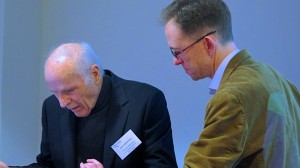
A key concern throughout the day was the legacy of Duchenne de Boulogne and the enduring influence of the idea of the passions in contemporary representations of the face. The starting-point for this dialogue was François Delaporte’s paper, ‘La Fabrique du visage et des passions’. Drawing upon Professor Delaporte’s landmark publications in the field, including L’Anatomie des passions (2003), the paper addressed the revolutionary influence of Duchenne, not only transforming understandings of the muscle physiology of the face, but also leading to repercussions in numerous other fields including medicine, art, literature, cinema and philosophy. The session was chaired by Professor Bernard Devauchelle, and led into a round table featuring François Delaporte, Bernard Devauchelle and the maxillo-facial surgeon Professor Iain Hutchison (St Bartholomew’s). The session identified numerous avenues for further discussion, and informed the consideration of modern and contemporary treatments of the face in philosophy and the arts later in the day. The second paper, by Julie Mazaleigue, discussed the representation of sexual desire, including representations of bodily dysmorphia, with special reference to the face and the gaze. The enquiry stretched from Franz von Bayros’ controversial illustrations of the nineteenth century all the way through to twenty-first century cinema. Alex Murray’s paper then questioned whether the face can be considered as biopolitical, assessing the brief analysis of the face in Agamben’s work and considering its articulation in technologies of security and surveillance. Joe Kember focussed on Harry Langdon’s facial performances in silent cinema of the early twentieth century. An exploration of facial grotesquery, the non-expressive face and the allegorical meaning of the face in silent cinema culminated in an analysis of the face in short silent film clips. David Houston Jones, meanwhile, discussed the enigma of the expressive and inexpressive face in the work of Samuel Beckett and the French photographer Luc Delahaye, considering Delahaye’s debt to Walker Evans and documentary traditions while also subverting contemporary and historical norms concerning the visual representation of the face. The final paper of the day came from Professor Patricia Skinner, who gave a cutting-edge account of the medieval face and the iconographical traditions which underlie it. In particular, Skinner’s paper considered the relationship of the passions to the deadly sins: love, pain, fear and anger and the pathological understanding of those states. Skinner assessed the diagnostic value of physiognomy texts – associating facial features with character traits and behavioural tendencies – frequently bound together with collections of medical texts after the 13th century.
Accompanying the workshop was a selection of artworks by Justin Jones, curated by Cristina Burke-Trees, ahead of the upcoming Faces of Conflict exhibition beginning in January 2015 at RAMM. Jones’s work draws upon two key strands of 1914FACES2014: the facially injured soldiers of the first world war, and the Passions, the theme of today’s workshop.
